EMERGENCY (NON-TRAUMA) SURGERY: EVALUATION AND MANAGEMENT
| EVALUATION OF THE ACUTE ABDOMEN |
Abdominal pain is one of the most common conditions encountered, serving as the chief complaint in 5%-10% of emergency department visits.1 Although this prevalence has not changed significantly over the last few decades, diagnostic accuracy has markedly improved. Hence, a more appropriate definition of an acute abdomen is the presence of abdominal pathology, which if left untreated (<72 hour history), will result in patient morbidity and mortality.
The goal of this chapter is to provide a guideline for the evaluation of the acute abdomen in the increasingly varied and complex populations of patients that has evolved with medical advancement and innovation. As risk factor analysis clearly identifies an association between time to diagnosis and therapy and outcome, a systematic approach is paramount.2–6 Pathophysiology. Abdominal pathology can cause visceral, parietal, or referred pain.
Visceral pain originates from bilateral innervation of the autonomic and visceral afferent type C fibers. Pain is sensed secondary to stretch but also distension, contraction, traction, compression, and torsion. In addition, mucosal pain receptors respond to chemical stimuli including ischemia and inflammation. The pain perceived is usually dull, not well localized, midline, and corresponds to the embryologic origin of the affected organ. Epigastric pain generally indicates a foregut etiology, as visceral afferent nerves from the foregut travel with the celiac trunk. Periumbilical pain indicates a midgut etiology as these afferent nerves travel with superior mesenteric artery branches. Lower midline pain indicates hindgut or pelvic pathology as these fibers travel with the inferior mesenteric artery branches. Parietal pain results from irritation of the parietal peritoneum leading to somatic nerve activation (type C and A delta fibers).6, 7 Chemical peritonitis occurs from irritation by blood, urine, or gastrointestinal (GI) secretions. However, intraperitoneal blood alone causes little inflammation or pain. Secondary infection of blood or breakdown products of blood leads to chemical peritonitis.
In contrast to visceral pain, parietal pain is sharp and well-localized. Appendicitis demonstrates both visceral and parietal pain. The inflammation and distension of the appendix (part of the midgut) classically results in poorly localized, dull periumbilical pain. As the inflammation progresses and irritates the parietal peritoneum, pain becomes sharper and better localized to the right lower quadrant (RLQ).
Referred pain is pain that is sensed on the superficial surface but caused by a visceral process; common patterns associated with certain abdominal processes are shown in Figure 33.1.8 Referred pain is the result of nerves carrying both autonomic and somatic innervation with both being activated. For example, the phrenic nerve and other afferents (derived from C3–C5 dermatomes) innervate the diaphragm and the associated peritoneum. Somatic C3–C5 dermatomes innervate the shoulder. Thus, the pain from intra-abdominal pathology irritating the underside of the diaphragm is referred to the shoulder via the common C3–C5 dermatome.6
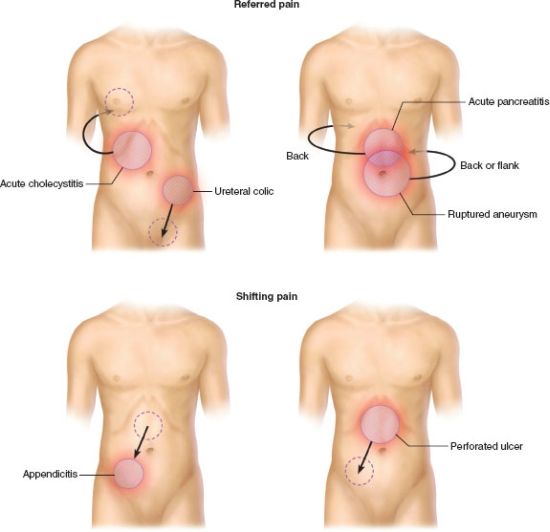
FIGURE 33.1. Referred pain and shifting pain in the acute abdomen. Solid circles indicate the site of maximum pain; dashed circles indicate sites of lesser pain. (Adapted from Doherty GM. The acute abdomen. In: Doherty GM, ed. Current Surgical Diagnosis and Treatment. 13th ed. New York, NY: McGraw-Hill/Lange; 2009 : Figure 21.2, pg 453.)
Differential diagnosis is extensive for acute abdominal pain. Thus, it is a clinical challenge for the acute care surgeon. Etiologies of acute abdominal pain can be divided into GI, vascular, gynecologic, urologic, and nonabdominal causes (Table 33.1).7
TABLE 33.1
ETIOLOGIES OF ABDOMINAL PAIN
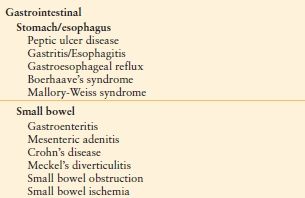
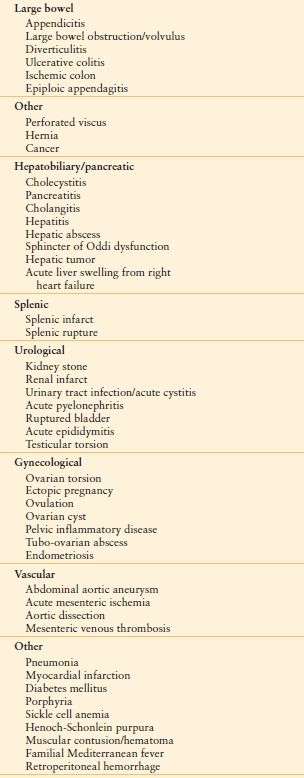
Adapted from Sahai RK, Forsythe RM. Evaluation of acute abdominal pain. In: Peitzman AB, Rhodes M, Schwab CW, et al., eds. The Trauma Manual. Trauma and Acute Care Surgery. Philadelphia, PA: Wolters Kluwer; 2008: 574–584.
HISTORY
A comprehensive history of present illness (HPI) , complete review of systems, and past medical history will rapidly narrow the differential diagnosis, and generally, yield an accurate diagnosis. A careful and detailed history is the most helpful factor in leading to a diagnosis. Ideally, the HPI would be the patient’s own description of the onset and progression of abdominal pain including duration, quality, location, intensity, radiation, and any ameliorating or aggravating factors. Identification of the location of pain helps to narrow the differential (Fig. 33.2).7, 8 However, location of the pain can be deceptive. For example, in perforated peptic ulcer disease, the source is the stomach but pain may be perceived along the RLQ secondary to gastric and pancreatic/biliary fluid tracking down the right paracolic gutter.
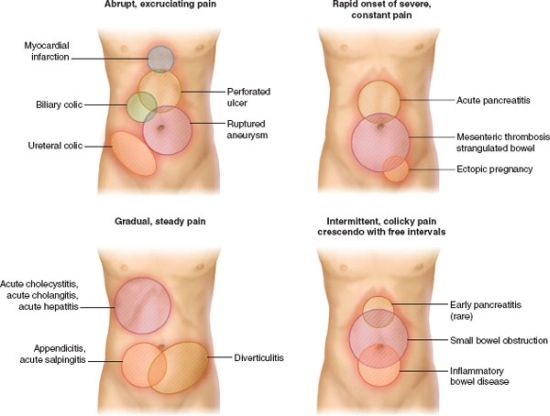
FIGURE 33.2. The location and character of pain are helpful in the differential diagnosis of the acute abdomen. Adapted from Doherty GM. The acute abdomen. In: Doherty GM, ed. Current Surgical Diagnosis and Treatment. 13th ed. New York, NY: McGraw-Hill/Lange; 2009: Figure 21.3, pg 454.)
Radiation of Pain. There are classic pain radiation patterns that strengthen a diagnosis (Fig. 33.1).
Periumbilical pain radiating to the back is associated with pancreatitis, perforated peptic ulcer disease, or aortic dissection. Subcostal left-sided abdominal pain with radiation to the shoulder may indicate an evolving myocardial infarction (MI), splenic pathology, or left subdiaphragmatic abscess. Right-sided abdominal pain may be seen with pleurisy or pneumonia. Pain from the flank radiating to the groin may indicate the presence of a ureteral stone.
Onset of Pain. Acute or abrupt onset of pain can be associated with a vascular etiology (acute mesenteric embolism, abdominal aortic aneurysm [AAA] rupture) or a perforated viscus. On the other hand, more gradual onset of pain is more characteristic of nonperforated peptic ulcer disease, cholecystitis, pancreatitis, diverticulitis, or appendicitis.
Character of Pain. Taken together with location, the character of pain gives further insight as to the abdominal process (Fig. 33.2). Cramping pain (colicky) is characteristic of bowel obstruction or gastroenteritis. Steadily increasing, constant pain indicates inflammatory and infectious etiologies, such as appendicitis, pancreatitis, cholecystitis, or diverticulitis.
Severity of Pain. Usually the greater the severity of the pain, the higher the likelihood of significant abdominal pathology. On the other hand, patient characteristics, such as personality, medications, age, comorbidities, can influence the perceived pain. Serially following the severity of abdominal pain is important; this should be performed by the same examiner whenever possible to avoid interobserver variability. Pain scales can also help reduce this variability. Determination of aggravating or alleviating factors can be helpful in evaluation of the pain. Sitting up and leaning forward classically decreases pain in patients with pancreatitis. Any movement aggravates pain in patients with peritonitis; someone bumping the bed, hitting potholes on the ride to the hospital. Associated symptoms help narrow a differential diagnosis. For example, bloody diarrhea, fever, and abdominal pain may indicate acute mesenteric ischemia or inflammatory bowel disease. Nausea and vomiting with diarrhea prior to the onset of pain helps make the diagnosis of gastroenteritis. Gynecologic/menstrual history must be obtained in all women. Pain in the middle of the menstrual cycle may indicate ovulatory pain. Absence of menses when expected may indicate the possibility of an ectopic pregnancy. Previous pelvic infections or sexually transmitted diseases may raise suspicion of pelvic inflammatory disease. Monthly cyclical lower abdominal/pelvic pain may indicate endometriosis.
Past medical history paints a picture of the patient’s overall health. In addition, known medical problems, prior operations and procedures (especially in our era of coronary stents and percutaneous angioplasty, and arterial stents), and current medications should be detailed. Comorbidities should be interpreted as potential sources of abdominal pathology (i.e., thromboembolic, mesenteric ischemia due to chronic atrial fibrillation). Diabetes or an immunosuppressed state may diminish perceived abdominal pain and minimize physical findings; the threshold for operative or other definitive intervention may be lower. Previous operations may suggest a postoperative complication or adhesions as a cause of bowel obstruction. A medication history is also important; certain diagnoses become more likely. For example, the use of nonsteroidal antiinflammatory drugs (NSAIDs) or corticosteroids would raise suspicion of a peptic ulcer or a perforated ulcer; digoxin use may raise the possibility of acute mesenteric ischemia; corticosteroids may mask significant underlying abdominal pathology. Allergies should be documented. A social history includes smoking, alcohol, and drug. Equally important are home, occupational, and travel exposures. For the unresponsive ICU patient, interview close family members, question the nursing staff, and review medical records.7
PHYSICAL EXAM
The general appearance of a patient helps with diagnosis and determination of the acuteness of treatment. Begin treatment of the acutely ill patient while working through the assessment and search for a diagnosis; treat the sick patient empirically, without a definitive diagnosis. A hypotensive patient with acute abdominal pain usually indicates concomitant septic shock, ruptured ectopic pregnancy, or rupture of a visceral or AAA. Other findings on examination may suggest the etiology of the abdominal pain. Patients with jaundice usually have a hepatobiliary source of their pain. A patient who is restless suggests renal colic as opposed to the patient with peritonitis who tries to lie motionless. Findings such as lethargy, sunken eyes, and poor skin turgor indicate dehydration, seen in cases of bowel obstruction, pancreatitis, and colitis with prolonged diarrhea.
Attention should then focus on the patient’s vital signs, considering that the threshold for concern must be tailored to the information gleaned from the historical exam. For instance, elderly patients will not match the physiologic response of younger patients. Similar forme fruste presentations are encountered in immunosuppressed or immunocompromised patients, who comprise an increasing proportion of the general population.
The abdominal examination is performed with the patient supine. Inspection of the abdomen for signs of bruising, mottling, erythema, and prior surgical scars should be noted. A bulge in the groin or umbilicus may be secondary to an incarcerated hernia and also the cause of the patient’s bowel obstruction. A flank hematoma (Grey-Turner’s sign) or periumbilical hematoma (Cullen’s sign) suggests severe hemorrhagic pancreatitis or ruptured AAA. Auscultation of the abdomen should document presence and character of bowel sounds. The presence of active, high-pitched bowel sounds indicates a mechanical small bowel obstruction. Absent or hypoactive bowel sounds suggest peritonitis or ileus. Bruits over the renal veins or visceral aneurysms may also be heard. If the patient is able, have him or her indicate with one finger the point of greatest pain. Percussion of the abdomen in all four quadrants may reveal tympany or dullness, and at times, peritonitis. Start with shallow palpation in the area of least pain and progress to the most painful area; this will help maintain a relaxed patient and enable a thorough exam. Involuntary guarding and rebound tenderness indicate peritonitis. A patient with rebound tenderness has exacerbation or onset of pain immediately after rapid removal of the examiner’s hand pushing deeply into the abdomen. The presence of peritonitis should not be tested by this method because of the extreme pain it causes; you will lose your patient’s trust. Instead, peritonitis can be assessed effectively by percussion, gentle palpation, rocking the patient’s bed, or tapping the patient’s heel. In a child, this can be assessed by having the child hop on one foot. Furthermore, the diffuseness of peritonitis dictates management. Diffuse peritonitis usually indicates an abdominal catastrophe and mandates surgical exploration. In a patient with altered mental status, grimacing, increased agitation, or purposeful attempts to move the hand of the examiner are “peritonitis equivalents,” as are physiologic changes of tachycardia, tachypnea, and hypertension in response to palpation. The costovertebral areas should also be palpated or lightly tapped. Tenderness may indicate acute pyelonephritis. Rovsing’s sign is more pain in the RLQ when pressure is applied to the left lower quadrant (seen with appendicitis). Psoas sign is pain with flexion or extension of the hip (seen in patients with psoas abscess or appendicitis, often retrocecal). The obturator sign is pain with internal/external rotation of the hip (appendicitis). Murphy’s sign is an abrupt stop in inspiration during palpation over the right subcostal area (seen in patients with acute cholecystitis).
The rectal exam with stool guaiac is an important part of a complete physical exam. Tenderness along the right rectal vault supports the diagnosis of appendicitis or an abscess. A guaiac-positive study suggests colitis, GI bleeding (i.e., peptic ulcer or colitis), or cancer.
In women with abdominal pain, a pelvic exam is essential to differentiate gynecological from other abdominal causes of pain. Cervical discharge is consistent with pelvic infection and pelvic inflammatory disease. A bimanual exam should be performed and can help diagnose pelvic inflammatory disease, an ovarian mass, or a tubo-ovarian abscess (TOA). Right upper quadrant pain may be from Fitz-Hugh-Curtis disease, perihepatitis from pelvic inflammatory disease.
Palpation of an uninvolved region (i.e., thorax) can help distinguish pain of true abdominal pathology from a response to mere tactile stimulation. Serial exams can provide invaluable information in the patient without an obvious indication for operative intervention. Ideally, serial exams are performed by the same individual to allow more accurate comparison and avoid interrater variability. Analgesia is often withheld under the premise it obfuscates evaluation of the pain and its progression. A 2007 Cochrane Review by Manterola et al. identified six randomized control trials evaluating the use of narcotic analgesia in the evaluation of acute abdominal pain. The review demonstrated that administration of pain medication increases patient comfort without impact on the timing or accuracy of diagnosis.3, 4
LABORATORY DATA
Laboratory data are adjunctive measures to support a diagnosis and should be tailored to the circumstances of the patient’s history and physical (Table 33.2). The commonly encountered “shotgun” battery of biochemical testing does little other than consume valuable resources and potentially obscure the diagnosis with superfluous information.5 However, in evaluation of a complex intensive care patient, in which time is of the essence, a broader approach is employed, which may incorporate an initial comprehensive set of biochemical and hematological studies. Nonetheless, these too should be customized to a differential obtained from the historical and physical examination. Test results should be evaluated not only as low, high, or normal, but also trended over time. Although the patient with an acute abdomen generally presents with an elevated white blood cell (WBC) count, an elevated WBC is not always seen in the acute abdomen. A “left shift” or “bandemia” can occur even if the total WBC is normal and is also indicative of an infection. The patient with dehydration (i.e., after excessive vomiting, third-spacing, or diarrhea) will present with hemoconcentration (elevated hemoglobin and hematocrit); an increased blood urea nitrogen/ creatinine (BUN/Cr) ratio (>20:1) is also indicative of dehydration. Hypochloremic, hypokalemic, metabolic alkalosis is often seen after prolonged vomiting. An anion gap metabolic acidosis (serum [Na]–serum [Cl]–serum [HCO3] >= 12) indicates uremia, diabetic ketoacidosis, or lactic acidosis as concomitant processes. Creatinine determination is often needed prior to a contrast computed tomography (CT) scan to determine risk versus benefit.
TABLE 33.2
BIOCHEMICAL AND HEMATOLOGICAL LABORATORY ANALYSES
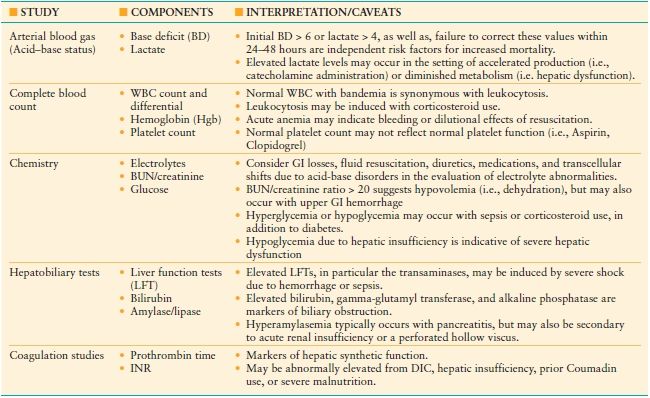
Liver Function Tests. Transaminases (aspartate aminotransferase/alanine aminotransferase (AST, ALT)’) may be elevated from numerous hepatobiliary disease states. Significant elevations indicate a hepatic process (i.e., viral hepatitis, abscess, ischemia, acetaminophen poisoning), usually with levels greater than three times normal. Lower levels can be nonspecific and due to a variety of causes including common bile duct stones, pancreatitis, steatohepatitis, and medications (i.e., statins). Alkaline phosphatase is produced by the cells lining the biliary tree. Elevation in its levels suggests a biliary process such as common bile duct stone, cholangitis, primary biliary sclerosis, or primary sclerosing cholangitis. However, alkaline phosphatase is produced by other organs including the gut, placenta, and bone. Therefore, a gamma-glutamyl transpeptidase GGTP level can be useful as it isolates the increased alkaline phosphatase as originating from the biliary tree.
The prothrombin time (PT) and albumin level indicate synthetic function of the liver. An elevated PT or decreased albumin level can indicate long-standing liver disease such as cirrhosis, important in the event a patient needs an operation. Pancreatic Enzymes. Amylase levels are elevated in pancreatitis with rise within 2–12 hours of symptoms and return to normal over next 3–5 days. Peak levels occur within the first 48 hours of symptoms.3, 9 Because of pancreas “burn-out” in chronic pancreatitis, levels can be normal despite an episode of acute, often severe, pancreatitis. Thus, amylase levels do not correlate with etiology or severity of pancreatitis. In addition, hyperamylasemia is nonspecific and may be seen with inflammation of the GI tract, many gynecological diseases, renal failure, and salivary gland inflammation. Lipase levels are elevated in pancreatitis, will rise slightly later (4–8 hours), peak earlier (24 hours), and return to normal longer (8–14 days) than amylase.3 Similar to amylase levels, lipase levels can be elevated in other intraabdominal pathology and renal insufficiency. Lipase levels are considered more specific than serum amylase for acute pancreatitis, especially in alcoholic pancreatitis.3, 9 However, levels do not correlate with etiology or severity.
Urinalysis (UA). Microscopic hematuria raises the possibility of a kidney stone or urological cancer. Pyuria, positive nitrite, and leukoesterase indicate acute pyelonephritis or cystitis. On the other hand, a “positive” urinalysis (i.e., with positive leukoesterase and few WBC’s) may be secondary to an inflammatory process in the abdomen such as appendicitis rather than a urinary tract infection. A pregnancy test is mandatory in women of child-bearing age.
Erythrocyte sedimentation rate and C-reactive protein are nonspecific markers of inflammation and acute stress that are not useful in the acute abdomen but may be followed over time to trend a patient’s response to treatment. Further study is needed to delineate the diagnostic utility in the acute abdomen of biomarkers such as procalcitonin.10
IMAGING
Improvements in abdominal imaging modalities have fostered a better appreciation of the advantages and limitations of each study in the evaluation of the acute abdomen.
X-ray. Plain radiographs of the abdomen and chest are inexpensive, portable, quickly performed tests, yet insensitive. They are a ‘confluence of shadows,’ dependent upon contrasting densities of apposed organs. Nonetheless, plain radiographs can reveal the dilated loops of a mechanical bowel obstruction, pneumoperitoneum of a perforated hollow viscus, or the thumbprinting indicative of pneumatosis. Portal venous gas may be seen in plain radiographs, related to intestinal ischemia or gas producing organisms. Calcifications may be seen in the pancreas, gallbladder, or aorta. Only 15% of gallstones are radiopaque, but 90% of kidney stones are opaque. The finding of a fecolith, occurring in 50% cases of appendicitis can be helpful.
Serial x-rays may be used to show the passage of previously administered oral contrast. However, if a CT scan is planned, no additional value is obtained from plain films in the evaluation of undifferentiated acute abdominal pain.11–13
Computed Tomography Scan. CT is a rapidly performed exam, although more expensive than plain films, which provides specific information about hollow and solid viscera, vasculature, muscles, and bones. However, the patient must be physiologically stable, as the CT suite is rarely equipped with resources to treat an unstable patient. Furthermore, the data would suggest that for moribund patients, the decision to operate should not be based on CT findings, and completion of the scan only delays surgical intervention.14
CT can be performed with or without intravenous or oral contrast. Patients with contrast allergies can be premedicated with a steroid and benadryl protocol. The administration of intravenous contrast provides an evaluation of organ perfusion, parenchymal injury, areas of differing perfusion (i.e., hematoma vs. parenchyma), and even thrombosis of vessels, but it has not been demonstrated to increase the rate of diagnosis.15–17 Oral contrast requires time for intestinal passage. It is generally not necessary for the evaluation of small bowel obstruction or trauma patients and is relatively contraindicated in patients for whom an emergent scan is desired. A recent retrospective study of various combinations of intravenous, oral, and rectal contrast for CT of patients with an acute abdomen noted no difference in accuracy of diagnosis in enhanced compared to unenhanced scans.16, 17 In the acutely ill patient, an unenhanced scan eliminates the risks associated with contrast aspiration and renal injury. If contrast is used, extraluminal free fluid can be evaluated by Hounsfield units (HU) to help determine its source and significance. Typically, serous fluid is 0–20 HU, exudative or purulent fluid is 20–40 HU, and blood is 40 HU.18 Although CT may be used to confirm the inflammatory changes of acute cholecystitis, remember that gallstones are commonly not seen (one-third) on CT.
Ultrasound

Full access? Get Clinical Tree









